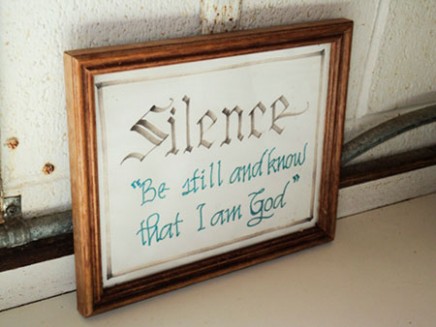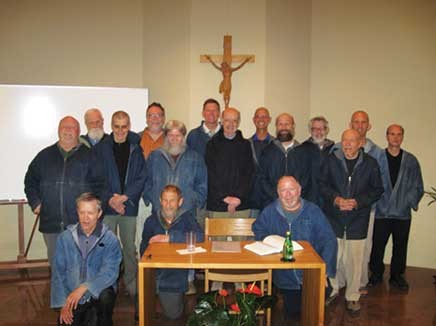Lifestyles of the (spiritually) rich and not so famous
 I’m in another world. This was my first thought as I sat in my cell—my simple living quarters—having just arrived at New Camaldoli Hermitage to observe life here. This chance to sample life as a hermit was part of the process of joining this small community of men located in the rugged mountains of the California Big Sur.
I’m in another world. This was my first thought as I sat in my cell—my simple living quarters—having just arrived at New Camaldoli Hermitage to observe life here. This chance to sample life as a hermit was part of the process of joining this small community of men located in the rugged mountains of the California Big Sur. I had come from a large Benedictine monastery in the Midwest, having been there for 15 years, steeped in my lifestyle as a brother who both worked in active ministry and prayed regularly. In my time I had been a professor, a clinical psychologist, and a director of formation (or initiation) for the community. Now I was leaving that behind in search of something I could only vaguely grasp, something very real, yet not easily described. Another world. I came from a large monastery—the main building itself was bigger than a football field.
Many monks, robed in their black habits, lived and prayed in common there in the heartland of America, with its wheat fields and regular seasons marking the passage of time. I taught, I counseled. Now I was sitting at the hermitage in my own cell in a community of white-robed monks, on the cliffs overlooking the Pacific Ocean, a place where daffodils bloom at Christmas, where real summer weather doesn’t come until September, with citrus trees and bougainvillea, plants I had never seen before, blooming outside my window. I would soon begin my regular work duties washing pots and pans. A very different world indeed.
A call apart
The image of being in a different world has remained with me during the four years I have been here. The externals that first so intensely grabbed my attention remain as reminders of the more subtle changes, already taking place within me in the Midwest, now coming to flower here in the mountains of California. I am not alone in this. The men here at the hermitage have all, in one way or another, experienced this call to live as hermits in a different world.
This calling is at the heart of our life and is at the heart of all who seek God’s path. It has to be at the heart of all who seek this way of life. The continual turning and being turned to the Lord—part of the baptismal call of all Christians and a central part of the monastic life—has been a process of stripping and of letting go, of opening myself to the possibilities of a life that blends the monastic and contemplative. Leaving behind those aspects of myself that were often center stage, being a teacher, a counselor, has not been easy. No longer defining myself by my work or skills brought me closer to who I really was—someone who wants to make my relationship with God my main focus.

Perhaps that is the defining characteristic of the contemplative. Here at New Camaldoli Hermitage we all strive to do just this, in the context of the monastic framework of work and prayer. Unlike most monastic communities, we do not work in schools or parishes. We do not have ministry jobs that take us away from the monastery.
Through our small guesthouse we offer hospitality to those who come to spend time with us. On occasion, one or another of the monks will be called upon to give a retreat. However, our life is primarily focused on seeking God on this mountain.
New awareness
This focus radically changed the thrust of my life—being a professor or a clinical psychologist no longer loomed large. Instead, paramount for us is the daily rhythm of prayer—both communal prayer and private—and work (see sidebar). This reordering of the externals of my life mirrored the inner reordering that was happening. Neither was, or is, easy, although it seemed so at first. I welcomed the initial change and it took time for the intensity of the hermit’s life to show itself: sometimes exciting, sometimes frightening, always challenging.
I began to grasp more clearly that the stripping, the letting go, had just begun, and in fact would be my main spiritual practice of this time. All for a purpose, to live more fully the contemplative monastic way as a means to God. It was beginning to be a very different life at one level, while seeming very mundane on another. With the life of a hermit comes a new awareness, a sense of another world simultaneous with the one I am so used to.
We live separately, but at least four times a day I come out of my cell and pass through creation. The solitude (in addition to the times of common prayer, we have only one meal in common each day), the slower pace, the absence of TV and radio, the lack of outside ministerial demands, all mean there is no escape from the work of seeking God.
This life has its own intensity. As hermit monks centered on the Lord, we strive to live simply and serenely, and to help each other, and those who come to us, to do the same. It is hard work! Although many who come here, like myself, have been involved in active ministry or professional work, no one comes here to retire. If anything, the demands of this life often seem more daunting than the busiest of days as a psychologist.
Who might be called to this life? Those who have come to an understanding of themselves, but who are seeking a deeper understanding of that fundamental relationship that undergirds all others: the relationship with God. Those who are successfully able to live in this world, but want to live in “another world” Inability to manage everyday needs and problems is a sure sign of not having a call to this life. It is a life of entering into, not escaping or withdrawing from.
Who else might be called? Those who desire solitude as a means of deepening their relationship with God, while having a love for and need of community. Loners and social isolates need not apply! Those who are willing to look at themselves, and let go of what they see for that which they cannot see. Those who have vigor and energy, who delight in this world and everything about it. Those who have a deep and abiding concern for others, and can live with the tension of never being able to even come close to addressing those concerns concretely.
Far from insulating ourselves from the cares of the world around us, I find I am more sensitive than ever to the problems facing our church and world. Newspapers, magazines, and the Internet keep us abreast of what is happening. The needs of those who come to us and write to us are before us, and we share in their lives. I am finding that the joy and pain of others is no less real for my being here—indeed it has only intensified. This life of contemplative monasticism, bringing together the disparate elements of solitude and community, withdrawal and involvement, emptying and being filled, has given me great joy.
This is another world, but one that seems to bring me closer to home than I have ever been. I strive to empty myself completely, and sit like a little chick, content with God’s grace; for if God, like a mother, does not feed us, we will have nothing to taste, nothing to eat.
Tags
Related
- Better together: Profile of Brother David Relstab, O.S.A.
- The secret’s out: Brotherhood is powerful
- Brothers win the race: Profile of Brother Rafael Vargas, S.D.B.
- God called me to be a brother
- Modern “prodigal son” meets the brothers: Profile of Brother Ray Morris, B.H.
- Brotherhood is right for me
- Big Brother is watching you
- Why did I become a brother?
- Brother Mark Elder makes an art of spirituality
- How God tricked Duc Pham into becoming a brother Read More
Most Viewed
- Find your spirituality type quiz
- FAQs: Frequently asked questions about vocations
- Celibacy quiz: Can you live a celibate life?
- Resources for older discerners or those with physical and developmental differences
- About Vocation Network and VISION Guide

